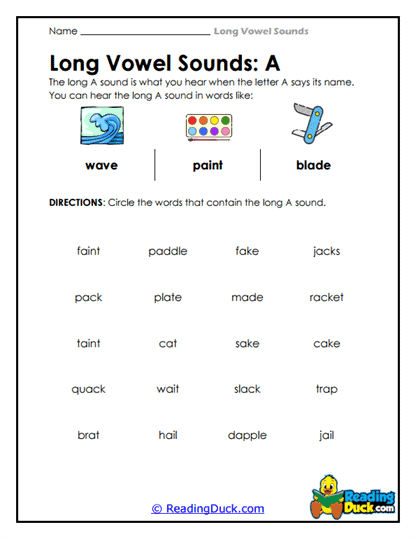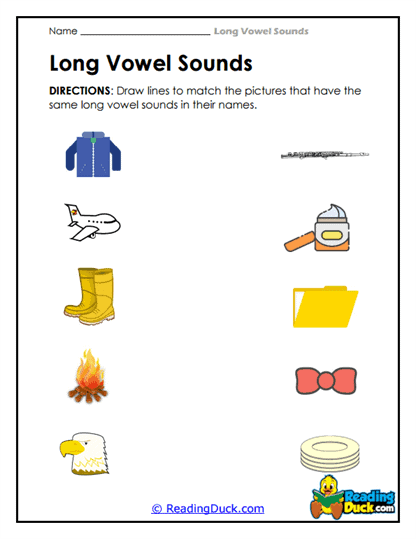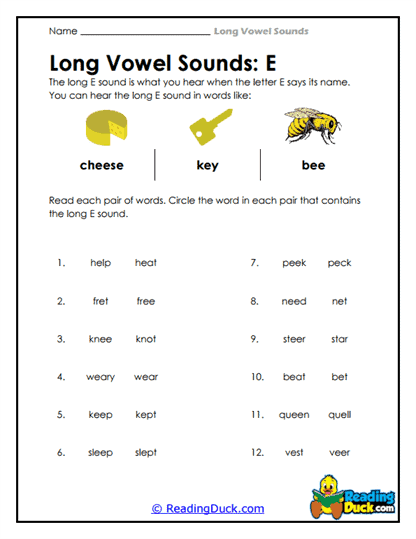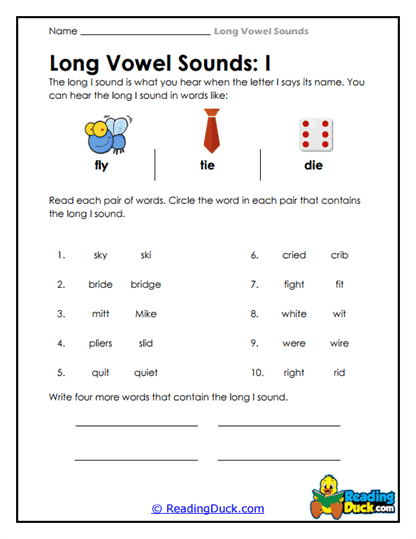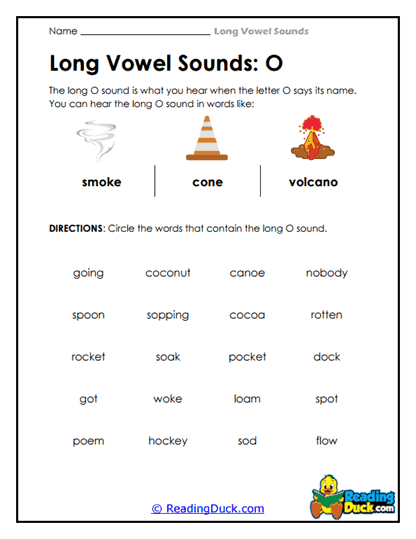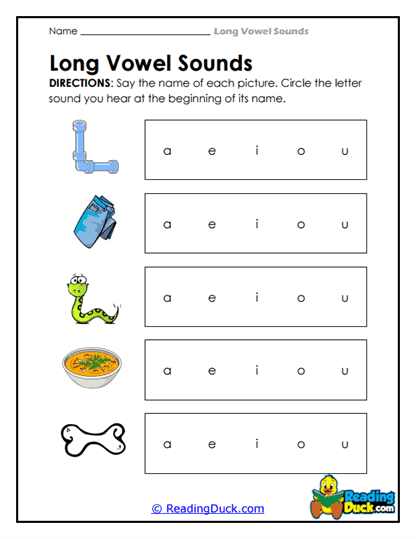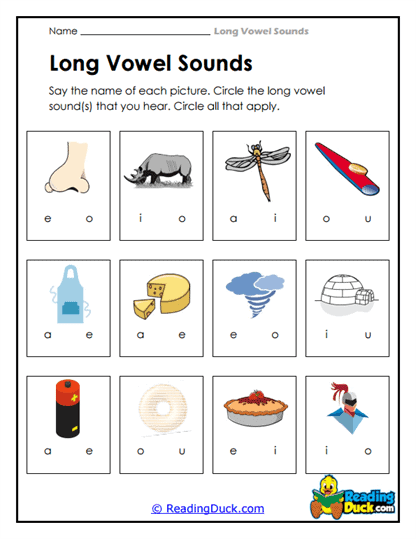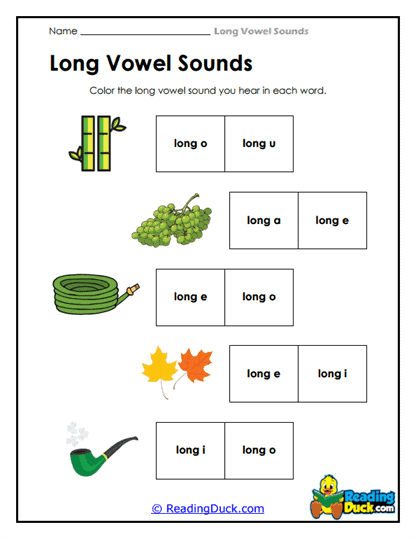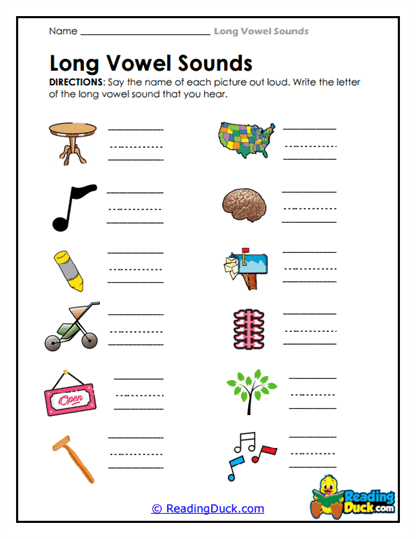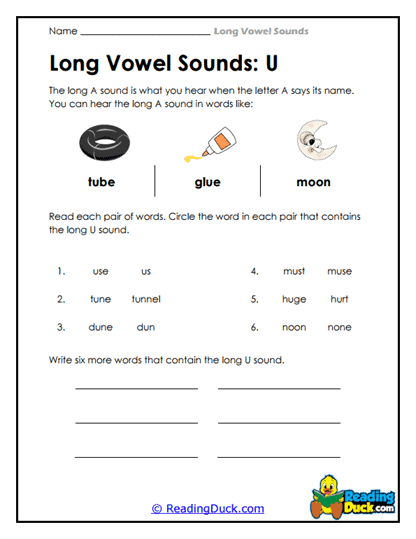Long Vowel Sounds Worksheets
About Our Long Vowel Sounds Worksheets
Our collection of Long Vowel Sounds Worksheets is an essential resource for young learners embarking on their literacy journey. As part of the 'Phonics' category within the 'Pre-Reading' section, these worksheets are specifically designed to support children in Pre-K through 1st grade. Each worksheet is carefully crafted to help students understand and practice long vowel sounds, which are critical for developing strong reading skills.
The worksheets are provided in a convenient PDF format, making them easy to view, download, and print. Additionally, each worksheet comes with a downloadable answer key, allowing educators and parents to efficiently assess and reinforce learning. This collection is designed to offer systematic practice, enabling children to master the concept of long vowel sounds and gain confidence in their reading abilities.
Understanding Long Vowel Sounds: A Key Component of Early Reading Development
Long vowel sounds occur when a vowel says its name, as opposed to the short vowel sounds that are common in many simple, one-syllable words. For example:
- The letter “A” in “cake” produces a long vowel sound.
- The letter “E” in “me” produces a long vowel sound.
- The letter “I” in “kite” produces a long vowel sound.
- The letter “O” in “home” produces a long vowel sound.
- The letter “U” in “use” produces a long vowel sound.
These sounds are integral to understanding more complex words and are a natural progression from learning short vowel sounds. Mastery of long vowel sounds allows students to accurately decode and pronounce a wider range of words, which is vital for advancing their reading skills.
Why Are Long Vowel Sounds Important?
Long vowel sounds play a crucial role in early reading development. Here’s why they are significant:
- Word Decoding: Long vowel sounds help children decode more complex words, moving beyond basic, short vowel sound words to include a broader vocabulary.
- Spelling Skills: Understanding long vowel sounds is essential for spelling, as many spelling patterns involve long vowels (e.g., silent “e” in “plane”).
- Reading Fluency: Mastery of long vowel sounds contributes to reading fluency, enabling children to read more smoothly and with greater confidence.
- Comprehension: Recognizing long vowel sounds enhances comprehension, as students can better understand and pronounce the words they encounter in texts.
Systematic Approach to Learning Long Vowel Sounds
Teaching long vowel sounds involves a structured approach, ensuring that students grasp the concept fully:
- Introduction to Vowel Pairs: Long vowel sounds often involve vowel pairs (like “ai” in “rain” or “oa” in “boat”). Teaching these pairs helps students recognize patterns.
- Silent “E” Rule: A common rule for long vowel sounds is the silent “e” at the end of a word (e.g., “cake” or “ride”). Educators can introduce this rule early to help students identify long vowel sounds in words.
- Practice Through Word Families: Grouping words into families that share the same long vowel sound (e.g., “cake,” “bake,” “make”) helps reinforce the sound and pattern.
- Phonemic Awareness: Developing phonemic awareness, or the ability to hear and manipulate sounds in words, is key to understanding long vowels.
How These Worksheets Support the Recognition and Practice of Long Vowel Sounds
Our Long Vowel Sounds Worksheets are thoughtfully designed to reinforce students’ understanding of this crucial phonics skill. These worksheets provide opportunities for students to recognize, differentiate, and practice long vowel sounds, contributing to their overall reading proficiency.
Building Recognition through Repetition
The worksheets offer repeated exposure to long vowel sounds, helping students to solidify their recognition of these sounds within different words. By encountering long vowels in various contexts, students are better able to identify them in their reading materials.
Encouraging Sound Discrimination
One of the key aspects of mastering long vowel sounds is the ability to distinguish them from short vowel sounds. These worksheets encourage students to practice this discrimination, honing their ability to hear the difference between similar-sounding words (e.g., “cap” vs. “cape”).
Progressive Learning Experience
The worksheets are designed to provide a progressive learning experience, gradually increasing in complexity as students build their skills. This approach ensures that students are not overwhelmed and can confidently advance through the material.
Supporting Independent Learning
As students become more familiar with long vowel sounds, these worksheets can serve as a tool for independent practice. This independence allows students to reinforce their learning at their own pace, fostering a sense of accomplishment and self-confidence.
Best Practices for Educators in Teaching Long Vowel Sounds
Introducing Long Vowel Sounds with Familiar Examples
Educators can begin teaching long vowel sounds by using words that are already familiar to students. Starting with everyday words that students frequently encounter helps them connect the concept to real-life language use.
Utilizing Visual and Auditory Aids
Incorporating visual aids, such as vowel charts or flashcards, along with auditory examples, like saying words aloud, can make the learning process more engaging. Visual and auditory reinforcement helps students better understand and retain the concept of long vowel sounds.
Incorporating Multi-Sensory Learning Techniques
Multi-sensory learning techniques, such as tracing letters while saying the corresponding vowel sound or using manipulatives like letter tiles, can enhance students’ understanding of long vowel sounds. These techniques cater to different learning styles, ensuring that all students can grasp the concept.
Creating Word Walls or Anchor Charts
Educators can create word walls or anchor charts that highlight long vowel sound patterns, such as vowel pairs or silent “e” words. These visual references can be displayed in the classroom and referred to during lessons, providing students with a constant reminder of the patterns they are learning.
Regular Assessment and Feedback
Consistent assessment and feedback are vital for helping students master long vowel sounds. Educators should regularly check students’ understanding through informal assessments, such as quick oral quizzes or review games, and provide immediate feedback to correct any misunderstandings.
Practical Ideas for Using Worksheets to Enhance Literacy Skills
Incorporating Worksheets into Daily Literacy Activities
These worksheets can be seamlessly integrated into daily literacy activities. Educators might use them as part of morning work, during literacy centers, or as a homework assignment. Consistent practice through these worksheets helps reinforce the long vowel concepts taught during lessons.
Combining Worksheets with Interactive Activities
To make learning more dynamic, educators can pair worksheets with interactive activities. For example, after completing a worksheet on a specific long vowel sound, students might participate in a matching game where they pair words with the same long vowel sound or create a simple story using words from the worksheet.
Encouraging Parental Involvement
Parents can play a crucial role in reinforcing what is learned at school. Educators can suggest that parents review the worksheets with their children at home, offering additional practice and support. Simple activities like reading aloud together or playing vowel sound games can complement the worksheet practice.
Using Worksheets as a Springboard for Creative Activities
Worksheets can also serve as a springboard for more creative literacy activities. After working on a long vowel sound, students could be encouraged to write their own sentences or short stories using words with that sound. This not only reinforces the sound but also encourages creative thinking and writing.
Adapting Worksheets for Differentiated Learning
The worksheets can be adapted to meet the needs of different learners. For advanced students, educators might challenge them to find additional words with the same long vowel sound or to write a story incorporating those words. For students needing extra support, simpler tasks or more guided practice can be provided.
The Importance of Long Vowel Sounds Worksheets in Building Reading Confidence
In conclusion, our Long Vowel Sounds Worksheets are a valuable resource for helping young learners develop essential reading skills. By focusing on the recognition and practice of long vowel sounds, these worksheets support students in building a strong foundation in phonics, which is critical for reading success.
The structured and progressive nature of these worksheets allows for gradual mastery of long vowel sounds, ensuring that students develop the confidence needed to tackle more complex words and texts. Educators and parents can use these worksheets effectively within both classroom and homeschool settings, providing consistent practice and reinforcing key phonics concepts.
Ultimately, the mastery of long vowel sounds through these worksheets is an important step in a child’s reading journey, helping to foster a love for reading and laying the groundwork for future academic success. By using these worksheets thoughtfully and creatively, educators and parents can significantly enhance a child’s early literacy skills, setting them on the path to becoming confident, proficient readers.
